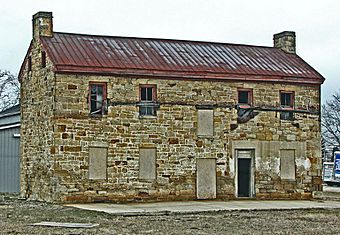Mary Worthington Macomb House facts for kids
Quick facts for kids |
|
|
Mary Worthington Macomb House
|
|

Front of the house
|
|
| Location | 490 S. Paint St., Chillicothe, Ohio |
|---|---|
| Area | 1 acre (0.40 ha) |
| NRHP reference No. | 76001525 |
| Added to NRHP | April 26, 1976 |
The Mary Worthington Macomb House is a historic home in Chillicothe, Ohio, United States. It is located on South Paint Street, right next to Paint Creek. This house is one of the oldest buildings still standing in Chillicothe today.
Contents
History of the Macomb House
The land where the Macomb House stands was once owned by Nathaniel Massie. He owned a large piece of land, about 35 acres. Building of the house started in 1813. It was finished two years later, in 1815.
Thomas Worthington's Purchase
In 1815, a very important person bought the property. This was Thomas Worthington. He was a former U.S. Senator. Later, he became the Governor of Ohio.
Mary Worthington Macomb's Story
Thomas Worthington had a daughter named Mary. She was born in 1797. Even though her family lived in a big house called Adena Mansion, Mary chose to marry David Macomb around 1816. His family was well-known in the area.
Mary and David Macomb lived in this two-story house. It is built mostly from large blocks of sandstone. The Macombs faced money problems. This made them move to the southern United States. Mary died in 1836 while they were moving to Texas.
Later Uses and Restoration
After the Macombs left, the property was used for businesses. By 1845, other buildings were added around the house. These included a frame building and a place for processing meat. These extra buildings are no longer there today.
In 1976, the Macomb House was added to the National Register of Historic Places. This means it is a very important historical site. It was recognized for its old architecture and its role in local history. It was important for trade and for the early settlement of the area.
By the early 2000s, the house needed a lot of repairs. It had become quite old and worn. People hoped to get money from a special government fund to fix it. It was estimated that fixing the house completely would cost about $500,000.



